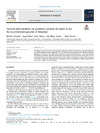Identificador persistente para citar o vincular este elemento:
https://accedacris.ulpgc.es/handle/10553/107973
| Campo DC | Valor | idioma |
|---|---|---|
| dc.contributor.author | Tomasini, Michele | - |
| dc.contributor.author | Duran, Josep | - |
| dc.contributor.author | Simon, Silvia | - |
| dc.contributor.author | Azofra, Luis Miguel | - |
| dc.contributor.author | Poater, Albert | - |
| dc.date.accessioned | 2021-06-21T11:43:59Z | - |
| dc.date.available | 2021-06-21T11:43:59Z | - |
| dc.date.issued | 2021 | - |
| dc.identifier.issn | 2468-8231 | - |
| dc.identifier.other | Scopus | - |
| dc.identifier.uri | https://accedacris.ulpgc.es/handle/10553/107973 | - |
| dc.description.abstract | The Milstein's reported discovery of hydrogenation of thioesters directly toward thiols and alcohols catalyzed by a Ru-acridine complex has been studied here by DFT calculations to know the origin of the different performance depending on the nature of the substituents. Unveiling the reaction mechanism leads to a deeper understanding of the steric and electronic properties on the nature of the limiting step of the reaction. Steric maps and Conceptual DFT have been the tools to rationalize the reactivity patterns. In addition, the nature of the catalyst has been studied, replacing the substituents on the phosphorous atoms by less sterically demanding groups with the aim to move to milder reaction conditions. | - |
| dc.language | eng | - |
| dc.relation.ispartof | Molecular Catalysis | - |
| dc.source | Molecular Catalysis [ISSN 2468-8231], v. 510, 111692 (junio 2021) | - |
| dc.subject | 221001 Catálisis | - |
| dc.subject.other | Homogeneous catalysis | - |
| dc.subject.other | Ruthenium catalysis | - |
| dc.subject.other | Thioesters | - |
| dc.subject.other | Reaction mechanisms | - |
| dc.subject.other | Density functional theory (DFT) | - |
| dc.title | Towards mild conditions by predictive catalysis via sterics in the Ru-catalyzed hydrogenation of thioesters | - |
| dc.type | info:eu-repo/semantics/article | - |
| dc.type | Article | - |
| dc.identifier.doi | 10.1016/j.mcat.2021.111692 | - |
| dc.identifier.scopus | 85109080117 | - |
| dc.contributor.orcid | 0000-0002-1366-1401 | - |
| dc.contributor.orcid | NO DATA | - |
| dc.contributor.orcid | 0000-0003-4935-1824 | - |
| dc.contributor.orcid | 0000-0003-4974-1670 | - |
| dc.contributor.orcid | 0000-0002-8997-2599 | - |
| dc.contributor.authorscopusid | 57224104751 | - |
| dc.contributor.authorscopusid | 7101940910 | - |
| dc.contributor.authorscopusid | 56278173200 | - |
| dc.contributor.authorscopusid | 55142490200 | - |
| dc.contributor.authorscopusid | 8533443400 | - |
| dc.relation.volume | 510 | - |
| dc.investigacion | Ciencias | - |
| dc.type2 | Artículo | - |
| dc.description.numberofpages | 6 | - |
| dc.utils.revision | Sí | - |
| dc.date.coverdate | Junio 2021 | - |
| dc.identifier.ulpgc | Sí | - |
| dc.contributor.buulpgc | BU-BAS | - |
| dc.description.sjr | 0,789 | |
| dc.description.jcr | 5,089 | |
| dc.description.sjrq | Q1 | |
| dc.description.jcrq | Q2 | |
| dc.description.scie | SCIE | |
| dc.description.miaricds | 10,1 | |
| item.fulltext | Con texto completo | - |
| item.grantfulltext | open | - |
| crisitem.author.dept | GIR IUNAT: Fotocatálisis y espectroscopía para aplicaciones medioambientales. | - |
| crisitem.author.dept | IU de Estudios Ambientales y Recursos Naturales | - |
| crisitem.author.orcid | 0000-0003-4974-1670 | - |
| crisitem.author.parentorg | IU de Estudios Ambientales y Recursos Naturales | - |
| crisitem.author.fullName | Azofra Mesa, Luis Miguel | - |
| Colección: | Artículos | |
Citas SCOPUSTM
16
actualizado el 08-jun-2025
Citas de WEB OF SCIENCETM
Citations
19
actualizado el 08-jun-2025
Visitas
175
actualizado el 22-feb-2025
Descargas
151
actualizado el 22-feb-2025
Google ScholarTM
Verifica
Altmetric
Comparte
Exporta metadatos
Los elementos en ULPGC accedaCRIS están protegidos por derechos de autor con todos los derechos reservados, a menos que se indique lo contrario.
